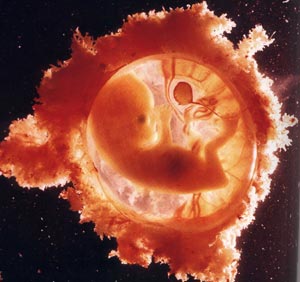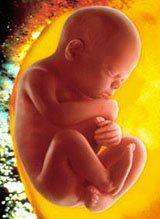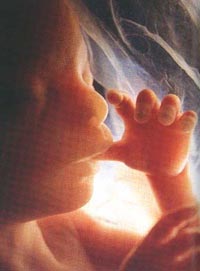Thanks to the integration of the most powerful medical imaging techniques – scanning and magnetic resonance imaging – with modern information technologies, radiologist Alexander Tsiaras has captured three-dimensional images of the most captivating mystery of life: the formation of a baby, from conception to birth.
“Microorganisms… like tiny pea seeds with long tails!” Scientist Antonie van Leeuwenhoek could hardly believe his eyes as he observed what he described as curled-up men and women trapped inside translucent packages. It was 1677. No ordinary eyes had ever seen such a thing before him. The microscope had just been invented, and he was the first scientist to use it to observe a patient’s sperm. “These microorganisms are so tiny – he marveled – that a million of them lined up end to end wouldn’t measure the size of a large grain of sand…” Thus began the journey into the incredibly small world to understand the origins of life.
Men sow seeds, women are just soil
 |
| Source: bio.m2osw |
This exploration also had its limits and led to other misconceptions at the time. Why did so many sperm only produce a single human? Why did the remaining sperm die? People once believed that “men sow seeds, women are just the soil!” This theory lasted for 150 years until the discovery of female gametes.
At the pinnacle of love’s behavior, the egg – round like a small ball, a droplet, a miniature planet, a sphere like the first form of the universe – awaits activation. The grand movements of fertilization begin. 300 million sperm start to “spar” with the egg. They share the same weapon: a flat head covered with enzymes designed to digest the cloud surrounding the egg and a tail as agile as a whip that propels them forward. Only 3 million of them penetrate the uterus. The distance to cover to get here is 20 cm. The speed is 1 cm per minute. Some sperm swim back up the fallopian tube without fertilizing the egg and die. The winner is among the rest. A few hundred sperm reach the target, but only one enjoys the glory of victory. The egg is ready. In an instant, the other sperm are expelled. They will linger around the egg for a few more days, like the suffering souls yet to be born, eventually dying and shattering their dreams… But for the victor, a new adventure begins, tiring and demanding.
In the early 20th century, American zoologist Edwin Brewster was astonished when he saw, through a microscope, how “a round cell suddenly deformed, elongated, rolled over and gave rise to complete living cells“. He explained: “This means that humans are not built like a wooden or concrete house, but like a brick house… We grow as these tiny living bricks divide into halves, which then grow into complete bricks…”
From a single brick
Today, in his work “The Mystery of Life, from Conception to Birth,” Alexander Tsiaras, along with science writer Barry Werth, employs the metaphor of a house to write a commentary: “Imagine you are a skyscraper, built in 9 months from a single brick. When the brick germinates and divides, it will produce all kinds of other materials necessary for the construction and operation of this massive tower… The first brick and its descendants know exactly how much of each component is needed, where to send the bricks, when and how to assemble them…“. Thus, each part, from the single cell, differentiates and finds its place, functioning precisely.
 The first fusion will last for 12 hours. During this process, 23 chromosomes from the mother combine with 23 chromosomes from the father. The code is inscribed in the mother’s cell: proliferation can begin. The chromosomes divide into two, with their thousands of genes. The matching copies remain attached to each other. Sometimes, they separate, giving rise to twins. Two days after fertilization, a new division begins: 4 cells become 8 (at this stage, fertilized eggs are often implanted in the uterus…) then 16, and then 32 by the end of day three. By days 9 to 12, the egg measures just 1/10 mm. As the whirlwind of cells increases rapidly, its size doubles with each division: 0.2 mm by the second week, where continuous folds and twists occur at a high pace, stretching this primordial egg into a blastocyst. By the third week, it grows to nearly 2 mm, taking on a shape with a head, eye positions, ears, a spine, and a beating heart. Throughout this miraculous time, the wife has not yet received anything. But the mother-child connection has begun. Morning sickness starts around day 25: a wave of subtle vibrations exchanges between mother and child. They only cease when the baby is born. The noise from outside, voices, music, or gentle, peaceful states, stress, or irritability, all act as messages to the fetus’s subconscious.
The first fusion will last for 12 hours. During this process, 23 chromosomes from the mother combine with 23 chromosomes from the father. The code is inscribed in the mother’s cell: proliferation can begin. The chromosomes divide into two, with their thousands of genes. The matching copies remain attached to each other. Sometimes, they separate, giving rise to twins. Two days after fertilization, a new division begins: 4 cells become 8 (at this stage, fertilized eggs are often implanted in the uterus…) then 16, and then 32 by the end of day three. By days 9 to 12, the egg measures just 1/10 mm. As the whirlwind of cells increases rapidly, its size doubles with each division: 0.2 mm by the second week, where continuous folds and twists occur at a high pace, stretching this primordial egg into a blastocyst. By the third week, it grows to nearly 2 mm, taking on a shape with a head, eye positions, ears, a spine, and a beating heart. Throughout this miraculous time, the wife has not yet received anything. But the mother-child connection has begun. Morning sickness starts around day 25: a wave of subtle vibrations exchanges between mother and child. They only cease when the baby is born. The noise from outside, voices, music, or gentle, peaceful states, stress, or irritability, all act as messages to the fetus’s subconscious.
A tiny being is born
At around 6-7 weeks, small bulges begin to appear on either side of the embryo, extending into buds that will later develop into limbs. Buds sprout all over the spring tree: for the primordial mouth and future jaws, for the nose, eyes, tongue, teeth… By day 25, we see a work of Picasso, by day 32, an E.T. – a creature from space with a head as large as half its body; by day 42, the Irish demon with a long tail resembling a dragon’s vertebrae. Then come the eyes, optic nerves, eyelids, stomach, liver, pancreas, spine, and kidneys, along with muscles. By week 9, with folds at the elbows on the now elongated arms, fingers, and hands…
In this extraordinary “factory,” all major organs of the body are created with enthusiasm and no downtime – the movement channel never stops. Unless… The brain performs extraordinary feats with a terrifying proliferation of new neurons at a pace of 100,000 neurons per hour! Suddenly, by week 8, the whirlwind halts just as quickly as it began: the head rises, the eyes widen, the arms and legs are completed, the thumb and index finger oppose each other, and the heart is divided into 2 ventricles, beating at 80 beats per minute: the embryo is complete. From now on, it is referred to as a fetus.
 Moreover, the fetus also has its own posture and resembles a frog with its eyes on either side. But soon, these eyes will gradually move closer together towards the front of the head, quickly giving them a more human appearance. The lips begin to form. By day 56, all organs differentiate from one another. At this point, the tiny human turns its head, moves its arms and legs. By 12 weeks, the fetus reaches an age where gender begins to manifest. An age where, according to embryologists, “the fetus begins to exhibit personal changes, certainly based on inherited behaviors from parents.” An age where the fetus starts sucking its thumb. This is also a stage where the fetus is most vulnerable to miscarriage from any jolt.
Moreover, the fetus also has its own posture and resembles a frog with its eyes on either side. But soon, these eyes will gradually move closer together towards the front of the head, quickly giving them a more human appearance. The lips begin to form. By day 56, all organs differentiate from one another. At this point, the tiny human turns its head, moves its arms and legs. By 12 weeks, the fetus reaches an age where gender begins to manifest. An age where, according to embryologists, “the fetus begins to exhibit personal changes, certainly based on inherited behaviors from parents.” An age where the fetus starts sucking its thumb. This is also a stage where the fetus is most vulnerable to miscarriage from any jolt.
When the danger passes, the baby grows rapidly: 20 cm and 250 grams by the fifth month. Its heart pumps 144 liters of blood per day throughout its body, beating like an athlete’s heart. Moreover, it can be heard through the mother’s belly. The baby sleeps and sucks its thumb. It thinks. Its eyes are closed.
Month eight is the month of dreams. The ninth month, finally, is when the baby learns to “go” to the bathroom. A rosy skin begins to smooth out, forming cute fingernails and toenails, eyebrows, eyelashes, and hair. It is time to prepare for birth. At that moment, it slowly swims around. The path has opened, the mother’s pelvis rotates (a perfection that the male skeleton cannot achieve). One day, it hears and feels a force pushing it out through a “narrow frame.” The front of the skull, then the head… A tiny human has just been born.


















































